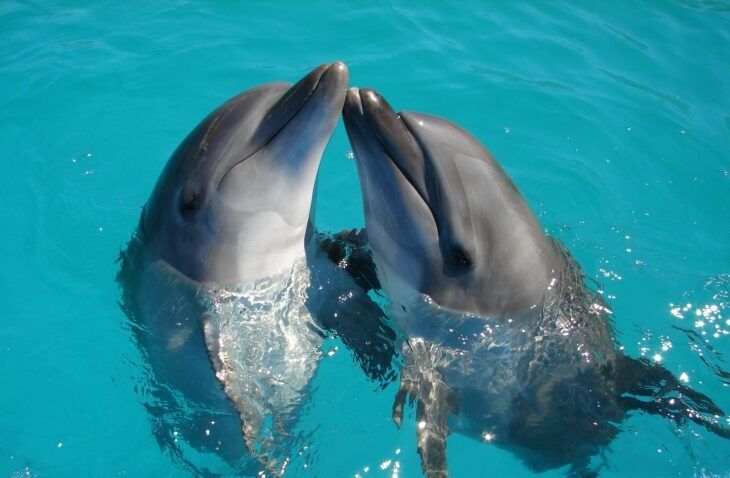Do you change your voice when talking to little kids? Whether consciously or not, parents across most human cultures use a higher-pitched voice, a wider vocal range, and shorter sentences when speaking to their young children or infants. Scientists call this phenomenon child-directed communication, or motherese. Motherese helps children bond with their parents and learn to speak on their own. But do other animal species have special voices for their young?
Researchers have found some songbirds, small monkeys, and bats modify their voices when in the presence of young. However, they can’t tell whether these animals are subtly changing their vocal patterns like humans do or using completely different vocal patterns. It’s like asking whether they’re singing the same song in a different key, or singing another song altogether.
An international team of biologists recently tested whether bottlenose dolphins speak motherese to their offspring. They chose dolphins because these highly intelligent marine mammals interact and communicate with each other in ways similar to humans. In particular, researchers have shown every dolphin has its own “name”, in the form of an individually distinctive signature whistle that helps dolphins recognize each other. Since motherese facilitates bonding and learning language in human children, the scientists hypothesized dolphins might use motherese in a similar way with their offspring, called calves.
The team compiled data from the Sarasota Dolphin Whistle Database, which includes nearly 4 decades of whistle recordings from the bottlenose dolphin community in Sarasota Bay, Florida. To make these recordings, scientists briefly encircled up to 4 dolphins in a net and loosely held them in the water. They attached an underwater sound recording device, called a hydrophone, to each dolphin’s forehead to record their signature whistles.
To test whether mother dolphins modify their signature whistles in the vicinity of their calves, the researchers examined recordings of 19 adult female dolphins. For each mother dolphin they compared 20 whistles recorded with her calf and 20 without. The calves were on average 2 years old, and ranged from 1 to 9 years old.
They used a type of sound analyzer called a spectrogram to measure the pitch, or frequency, of each whistle. Vocal frequency measures how fast or slow the dolphins’ vocal cords vibrate, which affects how high-pitched or low-pitched their whistles sound. Like with guitar strings, the fatter strings vibrate more slowly to produce low-pitched sounds, while the thinner strings vibrate more quickly to produce high-pitched sounds.
Every dolphin mom they studied produced signature whistles with maximum frequencies about 2 kHz higher with their calves than without. That’s like going up three octaves on a piano, from middle C to high C, but at frequencies too high for humans to discern. They also found the dolphin moms used a greater range of frequencies with their calves, like humans do with their offspring. The mother dolphins modified their whistles like this regardless of their age, their calf’s age, the presence of other dolphins, or their previous experience with being captured.
The team also analyzed the number of repeated whistle patterns, or whistle loops, the dolphins made, like repeating a melody. They found dolphin moms didn’t change the length or number of whistle loops they made with their calves, unlike humans who tend to speak in shorter sentences to their children. They suggested whistle loops might not be involved in dolphin motherese since not all dolphins make signature whistles with multiple loops.
The researchers confirmed that bottlenose dolphins speak a form of motherese to their offspring, but not why they do so. They explained dolphin moms could use it to teach calves their own signature whistles, but calves develop signature whistles within their first few months, so that can’t be the only reason. They suggested dolphins could continue speaking motherese to older calves to help them learn other types of whistles and vocal sounds, to keep in touch with them when in large social groups, or to bond with them like humans do with their young. Alternatively, differences in dolphin whistles could be a by-product of other physiological changes that happen during parenting, like lactation.
The team concluded dolphins modify their child-directed communication in a way more similar to humans than other animals previously tested. However, they were unable to determine whether dolphins can modify their whistle patterns as quickly as humans do, for example, depending on who they’re talking to at any given moment. They suggested future researchers test how flexible dolphin motherese is, and whether the calves actually prefer this type of vocalization, like human children do.


